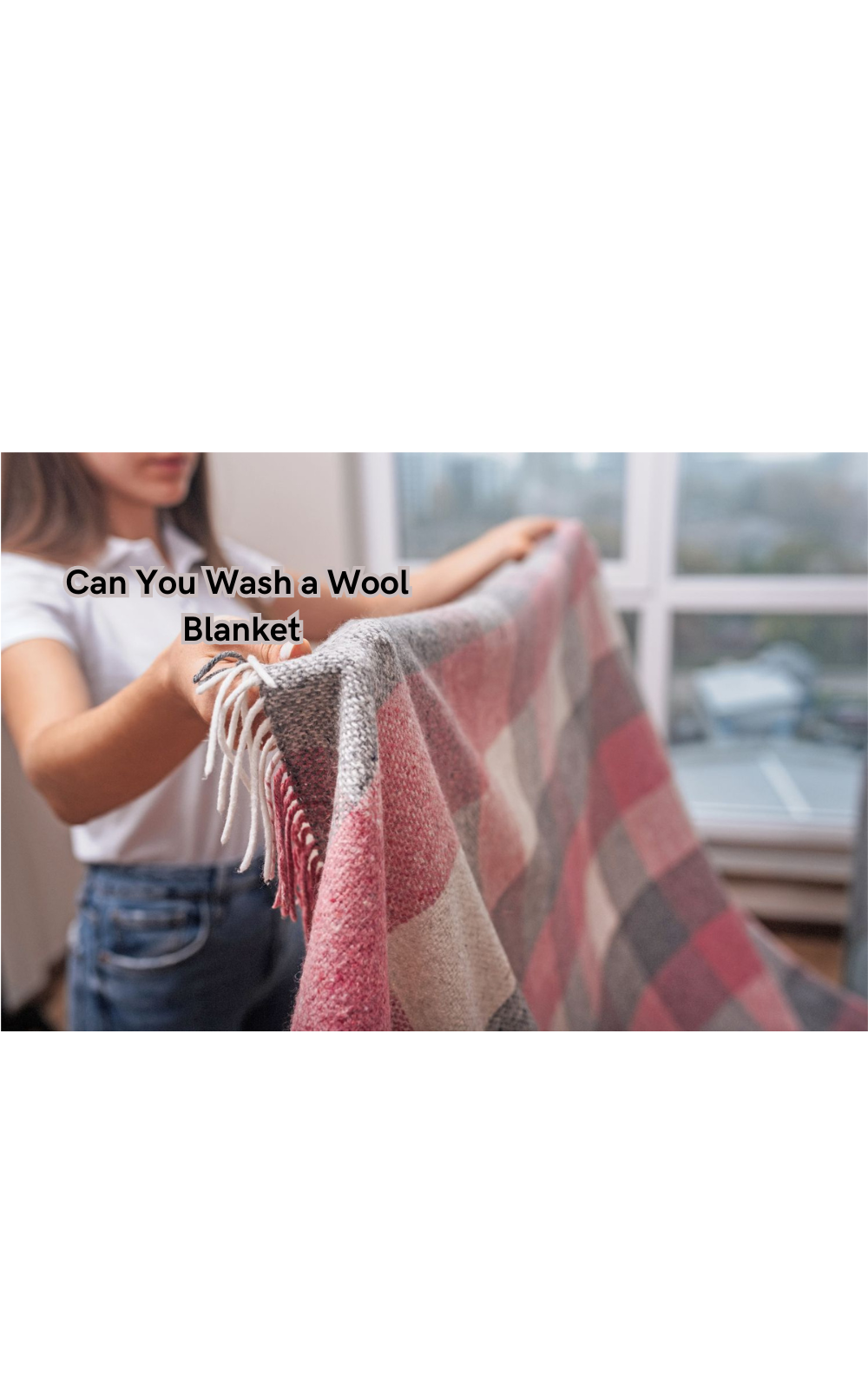Can You Wash a Wool Blanket
Let's delve into the considerations and best practices for washing wool blankets to help you effectively care for these cherished pieces.

Wool blankets are renowned for their warmth, softness, and durability, making them a cozy addition to any home. However, when caring for these blankets, questions may arise about washing them. The delicate nature of wool requires special attention to maintain its quality.
Many wonder if wool blankets can withstand washing without compromising their integrity. Understanding the proper cleaning techniques is crucial to ensure your wool blanket remains clean and fresh while preserving its luxurious feel.
Let's delve into the considerations and best practices for washing wool blankets to help you effectively care for these cherished pieces.
Overview of Wool
Before we dive into the washing process, let's first understand what makes wool unique. Wool is a natural fiber from sheep or other animals, such as alpaca, llama, and cashmere goats. The fibers are known for their insulating properties, making them ideal for blankets to keep you warm during colder months.
Wool is also water-resistant, meaning it repels liquids and dries quickly, preventing moisture from being trapped in the fabric. This quality makes wool blankets suitable for outdoor use or as an extra layer during wet weather.
Another notable characteristic of wool is its ability to regulate temperature. It can absorb moisture when it's hot and release it when it's cold, providing a comfortable sleeping experience year-round.
Can You Wash a Wool Blanket?
The short answer is yes, you can wash a wool blanket, but it requires specific care and attention. Wool is a delicate material that can shrink or lose its shape when exposed to hot water, agitation, or harsh chemicals. Therefore, following the proper washing techniques is essential to avoid damaging your wool blanket.
Furthermore, it's crucial to check the care instructions provided by the manufacturer before washing your wool blanket. Some may recommend dry cleaning only, while others may allow hand or machine washing. Plus, these instructions may vary depending on the type of wool used in your blanket.
Hand Washing vs. Machine Washing
When washing your wool blanket, you have two options: hand washing or machine washing. Both methods can effectively clean your blanket, but hand washing is the preferred and safest for delicate wool fabrics.
Guidelines before Hand Wash
If your wool blanket is hand-washable, follow these guidelines before starting the washing process:
- Check for any stains or spots and pre-treat them with a mild detergent.
- Fill a tub or sink with lukewarm water and add a small amount of gentle detergent suitable for wool.
- Turn the blanket inside out to protect its fibers from direct contact with the detergent.
- Soak the blanket for about 10 minutes, gently swishing it around in the water to loosen any dirt or debris.
Hand Washing Wool Blankets
To hand wash a wool blanket, follow these steps:
- Fill a tub or sink with cold water and add a small amount of mild detergent.
- Gently agitate the blanket in the water for a few minutes, making sure it is fully submerged.
- Rinse the blanket with cold water until all soap residue is removed.
- Carefully squeeze out excess water without wringing or twisting the fabric.
- Lay the blanket flat on a towel and roll it up to absorb more moisture.
- Unroll the blanket and lay it flat on a drying rack or clean towel, reshaping it to its original size.
- Let the blanket air dry completely before using or storing it.
When you are done hand washing your wool blanket, you can be confident that it will retain its softness and shape. Drying in sunlight can help disinfect the blanket naturally.
Guidelines about Washing a Wool Blanket in a Machine
When it comes to washing wool blankets, the golden rule is always to follow the manufacturer's instructions. However, if these are unavailable, you can use these general guidelines as a starting point.
- Check for Stains: Before washing your wool blanket, check for any stains or spots and pre-treat them with a mild stain remover. Avoid using harsh chemicals or bleach, as they can damage the wool fibers.
- Use Cold Water: When washing a wool blanket, avoid hot water, as it can shrink and damage the fibers. Instead, opt for cold water and set your Machine to a gentle cycle.
- Choose a Wool-Safe Detergent: Regular laundry detergents can be too harsh for wool fibers, causing them to lose their softness and shape. Instead, opt for a specially formulated wool detergent or one that is gentle on delicate fabrics.
- Avoid Agitation: Agitating the blanket in the washing machine can cause the fibers to tangle and feel, resulting in a distorted shape and texture. Therefore, it's best to let the Machine do the work without any additional agitation.
- Lay Flat to Dry: Once the washing cycle is complete, remove the blanket from the Machine and gently squeeze out excess water. Do not wring or twisting the fabric, which can lead to stretching and distortion. Lay the blanket flat on a towel to dry, away from direct sunlight or heat sources, which can also damage the fibers.
How to wash the blanket in the Machine:
- Check for stains and pre-treat them with a mild stain remover.
- Set your Machine to a gentle cycle with cold water.
- Use a wool-safe detergent or one that is gentle on delicate fabrics.
- Avoid additional agitation by letting the Machine do the work.
- Lay the blanket flat to dry, away from direct sunlight or heat sources.
Spot-Cleaning Method for Wool Blankets
For smaller stains or spills, spot-cleaning is a quick and effective way to clean your wool blanket without having to wash it entirely. Here's how you can do it:
- Mix a solution of cold water and mild detergent in a bucket or sink.
- Dip a clean cloth or sponge into the solution and gently dab it onto the stain, working from the outside in.
- Rinse the area with cold water and blot dry with a towel.
- Air-dry the blanket by laying it flat on a towel away from heat sources.
Maintaining Your Wool Blanket
To keep your wool blanket in pristine condition for years to come, here are some additional tips and tricks to keep in mind:
- Store it Properly: When not in use, store your wool blanket in a cool, dry place away from direct sunlight. Avoid storing it in plastic bags or containers, which can cause musty odors and attract moths.
- Avoid Heat Sources: Wool is sensitive to heat and can easily become damaged when exposed to it. Avoid using a clothes dryer or iron on your wool blanket, as the heat can cause shrinkage and distortion.
- Rotate Regularly: To avoid uneven wear and tear, rotate your wool blanket regularly, especially if you use it daily. This will help maintain its shape and softness over time.
- Air Out Periodically: If you store your wool blanket for an extended period, make sure to air it out periodically to prevent musty odors and keep it fresh.
How Often Should You Wash Your Wool Blanket?
Wool blankets, prized for their warmth and durability, require special care to maintain their quality.
When it comes to washing wool blankets, it's essential to handle them with caution to prevent damage. According to sources like The Spruce and HGTV, washing wool blankets should be done infrequently, with some recommendations suggesting washing every three months if used daily. Wool blankets can be hand-washed or machine-washed in cold water using gentle cycles.
Avoid hot water and dryers to prevent shrinking and damage to the wool fibers. Proper care and maintenance can ensure that your wool blanket will last for years, providing warmth and comfort whenever needed. So, make sure to follow these tips and guidelines when washing your wool blanket to keep it in optimal condition and enjoy its benefits for a long time.
FAQs
How should you wash wool blankets to maintain their quality?
To wash wool blankets, use a gentle detergent and select a wool cycle on your washing machine, if available, to ensure the fabric is treated delicately. Alternatively, hand washing in cool water can be a safer option. After washing, gently press out excess water without wringing the blanket, as this can damage the fibers.
What is the best way to store wool blankets when not in use?
Store wool blankets in a cool, dry place away from direct sunlight to prevent fading and fiber damage. Before storing, ensure the blanket is clean and completely dry to avoid mildew growth. Fold it neatly and place it in a breathable cotton storage bag to protect it from dust and pests.
Can you use a regular washing cycle for woolen blankets?
No, it’s recommended to use a wool cycle when washing woolen blankets, as it is specifically designed to handle delicate fibers gently. The wool cycle uses cooler water and slower spin speeds to prevent shrinking and felting of the wool fabric.
How do you use a soft bristled brush in wool blanket care?
A soft-bristled brush can be used to gently remove surface dirt and lint from wool blankets. Brush in the same direction as the fibers to avoid damaging the material. This can be part of regular wool blanket care to maintain its appearance and texture.
Conclusion
In conclusion, caring for a wool blanket involves maintaining its premium qualities over time. While the question of washing wool blankets may arise, it is indeed possible with the right approach.
By following expert advice on infrequent washing, utilizing cold water, and gentle cycles, you can keep your wool blanket clean without compromising its integrity. Remember to air dry flat to prevent distortion and maintain the blanket's shape.
Regularly airing out your wool blanket and spot cleaning as needed can also extend the time between washes. With proper care and attention to detail in washing and drying, your cherished wool blanket will continue to provide warmth, comfort, and luxury for many cozy nights ahead.
